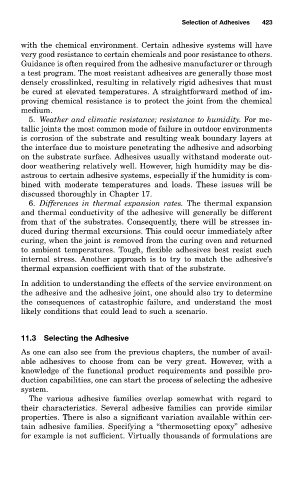Page 487 - Handbook of Adhesives and Sealants
P. 487
Selection of Adhesives 423
with the chemical environment. Certain adhesive systems will have
very good resistance to certain chemicals and poor resistance to others.
Guidance is often required from the adhesive manufacturer or through
a test program. The most resistant adhesives are generally those most
densely crosslinked, resulting in relatively rigid adhesives that must
be cured at elevated temperatures. A straightforward method of im-
proving chemical resistance is to protect the joint from the chemical
medium.
5. Weather and climatic resistance; resistance to humidity. For me-
tallic joints the most common mode of failure in outdoor environments
is corrosion of the substrate and resulting weak boundary layers at
the interface due to moisture penetrating the adhesive and adsorbing
on the substrate surface. Adhesives usually withstand moderate out-
door weathering relatively well. However, high humidity may be dis-
astrous to certain adhesive systems, especially if the humidity is com-
bined with moderate temperatures and loads. These issues will be
discussed thoroughly in Chapter 17.
6. Differences in thermal expansion rates. The thermal expansion
and thermal conductivity of the adhesive will generally be different
from that of the substrates. Consequently, there will be stresses in-
duced during thermal excursions. This could occur immediately after
curing, when the joint is removed from the curing oven and returned
to ambient temperatures. Tough, flexible adhesives best resist such
internal stress. Another approach is to try to match the adhesive’s
thermal expansion coefficient with that of the substrate.
In addition to understanding the effects of the service environment on
the adhesive and the adhesive joint, one should also try to determine
the consequences of catastrophic failure, and understand the most
likely conditions that could lead to such a scenario.
11.3 Selecting the Adhesive
As one can also see from the previous chapters, the number of avail-
able adhesives to choose from can be very great. However, with a
knowledge of the functional product requirements and possible pro-
duction capabilities, one can start the process of selecting the adhesive
system.
The various adhesive families overlap somewhat with regard to
their characteristics. Several adhesive families can provide similar
properties. There is also a significant variation available within cer-
tain adhesive families. Specifying a ‘‘thermosetting epoxy’’ adhesive
for example is not sufficient. Virtually thousands of formulations are

